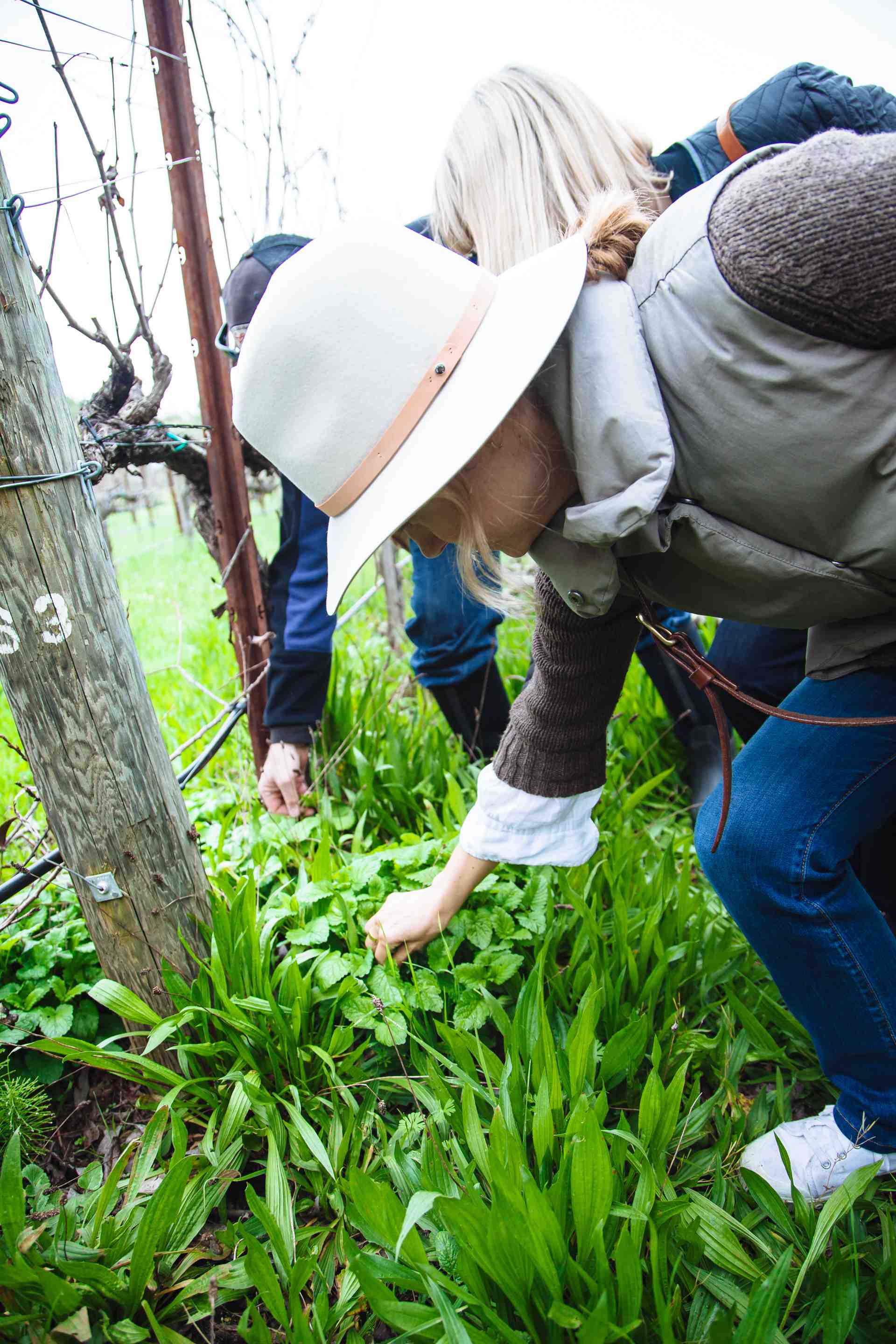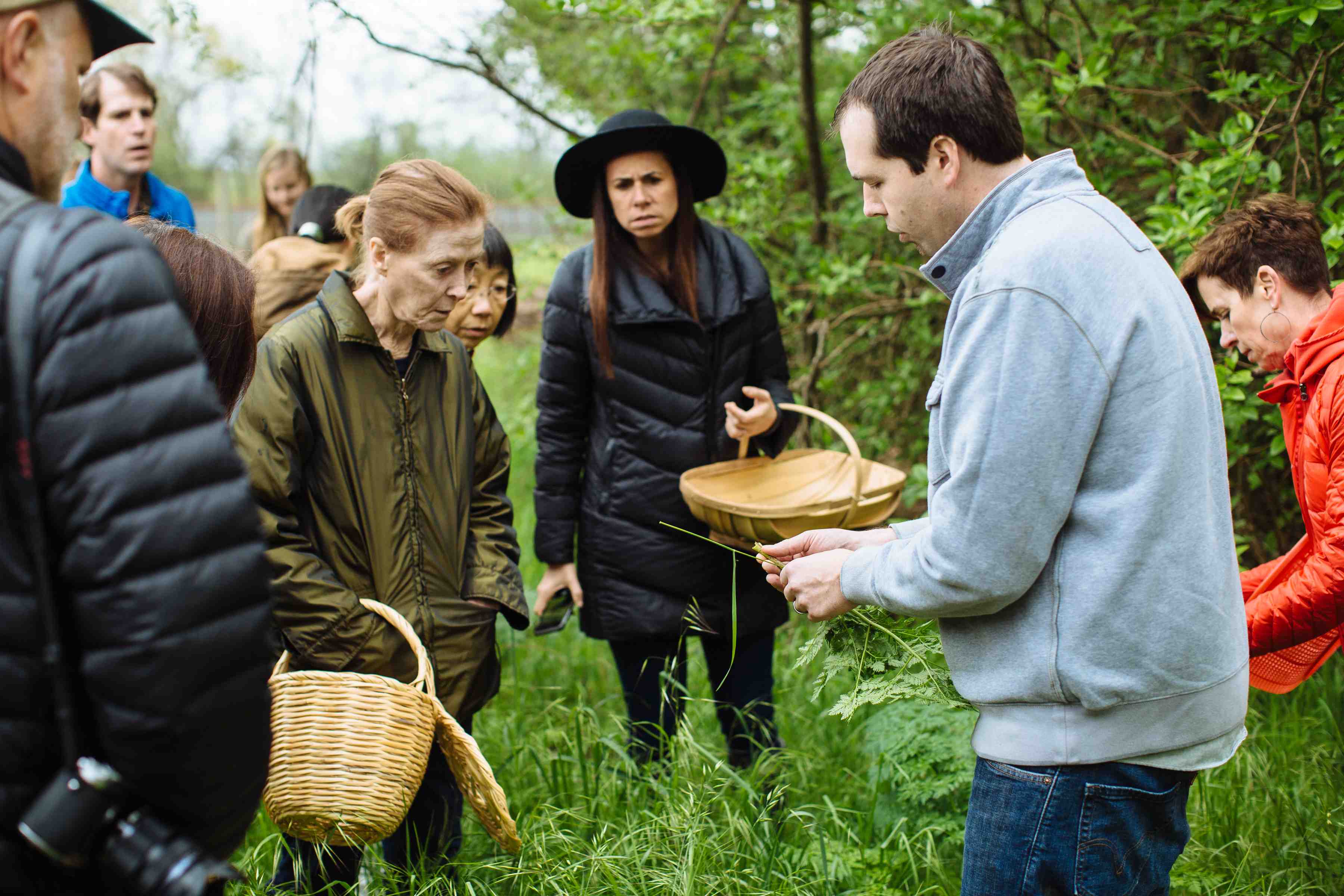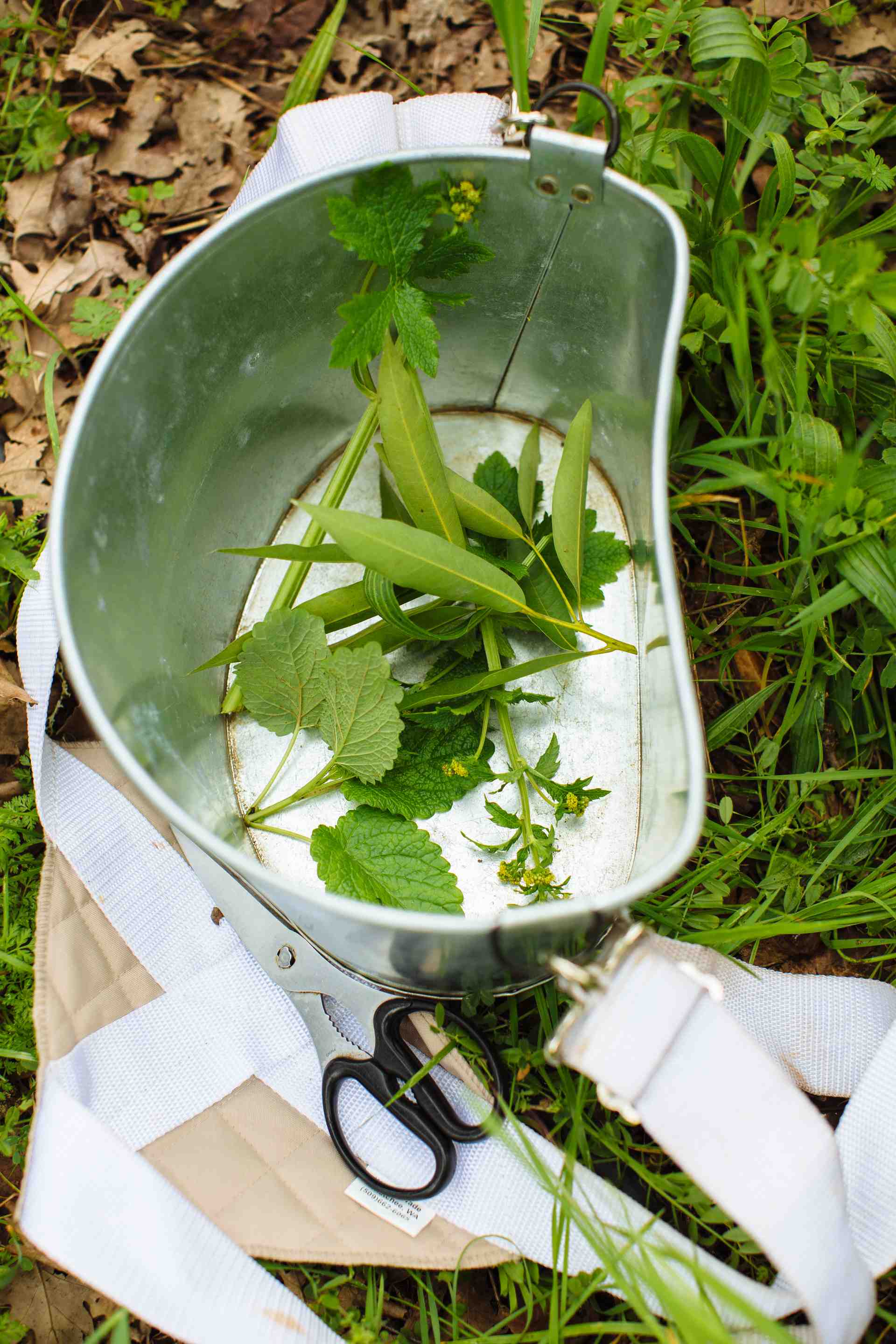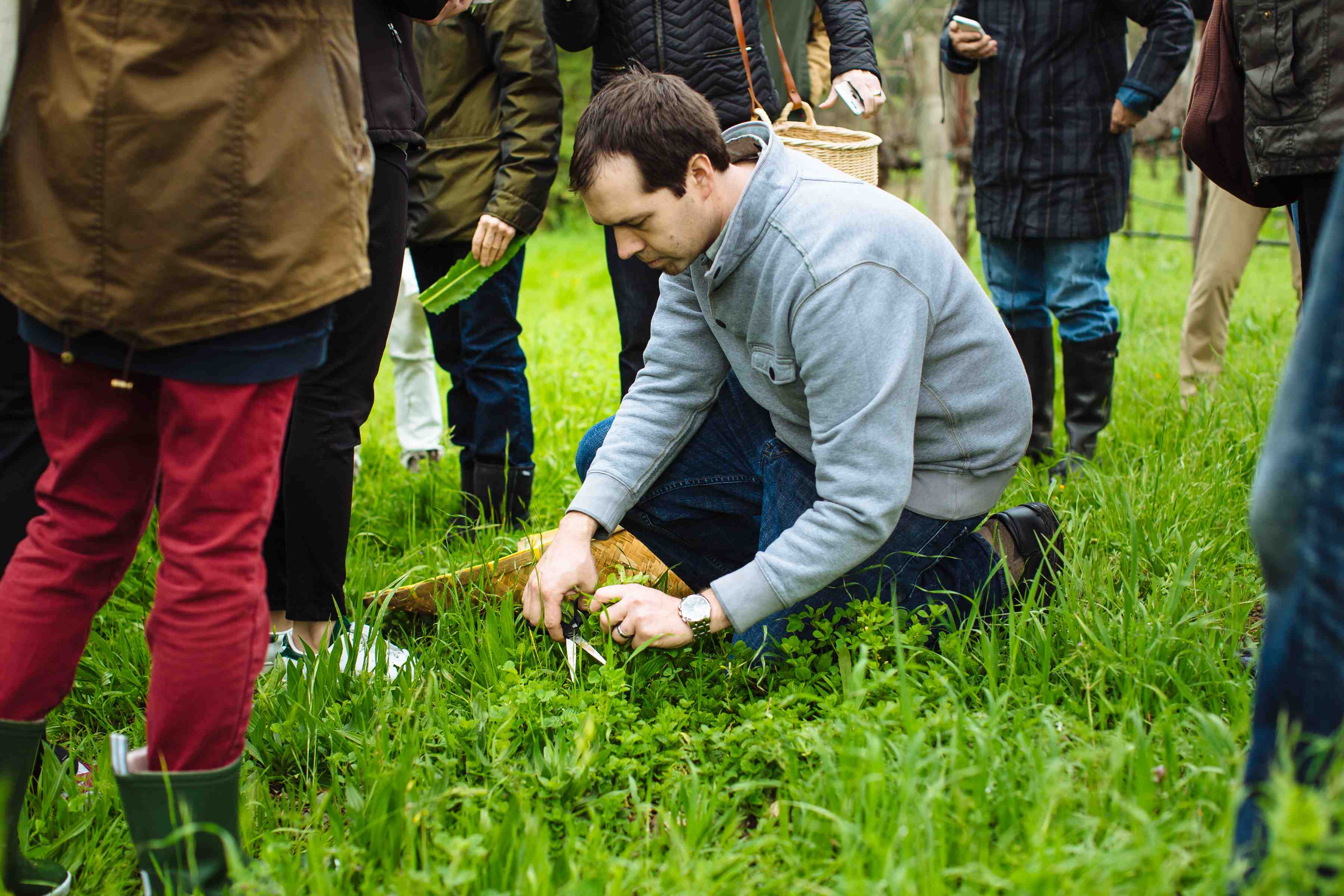Foraging is the best way to find true California cuisine.
On a drizzling spring morning in Northern California, Healdsburg SHED’s culinary director Perry Hoffman leads a group walk along Grape Creek. Hoffman and his chef de cuisine, Bryan Oliver, are experienced foragers seeking the wild foods that naturally grow in northern Sonoma County: Land and water cresses, miner’s lettuce, calendula, wild carrot—a poetic litany of tart flavors and green notes. And walking with them suddenly makes all the meadow but one buffet.
Local oak lichen can be eaten, Hoffman explains to the group, as long as it’s been blanched at least twice to remove its acid. You won’t die if you don’t blanch it. You’ll just wish that you could die. Fried, he says, it’s as good as any potato. People put sour cream and onion powder on the stuff. “They turn this wild poisonous thing into a junk food,” he exclaims.
Poison hemlock blooms all over our hillsides and hints at something you want to eat—like chervil or carrots or cowslip—but it will kill you as surely as it did Socrates. A hollow stem is its identifier.
“It looks like a tender yummy green,” Hoffman says. “It’s not.”
While there are plenty of plants that you can put directly from the ground into your mouth, there are many more that need to be leached with water for safety. Acorns. Nettles. Dock.
“There’s no reason to eat it if we don’t know it,” Hoffman says about wild plants in general. “You can try putting it in your mouth. Ninety-nine percent of the time, if it tastes good, it’s edible.”
I think about the Neanderthal woman, the bronze of her back rubbed bright by millions of passing hands, screwing her face into a grunt as she leans onto her heels, caught in the act of pulling a root from the ground. She’s immobile in the middle of the Smithsonian’s Hall of Human Origins, forever foraging.
Ancient peoples ate meat because so many plants carry poison. They ate meat because meat provides so much food. But at least you can pull a root from its spot in the ground. Wooly mammoth rarely stayed still.
We continue to wander. Hoffman points out vetch, pea shoots, Bracken fern, Pennyroyal. Spice bush, or wild allspice, abounds and Hoffman uses it to flavor drinking vinegars. Calendula doesn’t taste like anything but itself, he says. It’s not tarragon or rosemary or bay or any of those other flavors that we’re so familiar with. It just tastes like calendula.
I warn a family from Texas away from the glossy poison oak that abounds alongside the creek. They’ve been told about it but aren’t sure what it looks like. It’s a ninja, I tell them. It looks like this—and I point to a large shiny leaf. It looks like that—and I point to a naked stem. It looks like this—and I point to small bunch of bumpy leaves that are barely glossy at all.
Later that day, Hoffman and Oliver will take the morning’s finds and use them to create a salad scattered loosely across a marble table that guests will scoop onto their plates. The chefs will use other tenders to accompany spring lamb. They’ll take wild herbs and flowers as a cover to French cheese for dessert.
“Our favorite ingredients, as chefs, are those we don’t have to do anything to,” Hoffman exclaims.
I pick a purplish honeysuckle flower from the vine and remove the flower’s stem cap to suck out its mild minute sweet as I’ve done since childhood. I offer one to the mother from Texas. She smiles but doesn’t accept the offer.
Meanwhile, on this same morning in Southern California, professional forager Pascal Baudar is in his kitchen. Spring is his busiest time of year, tantamount to a farmer’s autumn harvest, and he is trying to find and keep all the many foods that briefly bloom in the desert so that he can preserve them for the rest of the year.
Baudar makes beer, vinegars, pickles, syrups, sugars, salts, seasonings, and more from the wild foods he finds.
“If you look at ancient society,” he says later by phone, “most of their time was spent in preserving food for the future. Wild food and preservation go back for the millennia. It takes time, but I’m playing with over 400 ingredients, from which I can basically create an infinite amount of preserves by mixing them and combining them.”
“We’re never going to give a you a plate of yarrow,” Perry Hoffman assures his Northern California group. “We like it for the flavors it brings to the whole. But a yarrow salad would be gross.”
While Hoffman and his group is only foraging for plants, Baudar has just come from a bit of a kill, collecting among the millions of caterpillars briefly alive in the desert near his home.
“Caterpillar was the major food source for natives and I’d never tried it,” he says, the French accent of his Belgian heritage as strong as black coffee. “I thought I’d be disgusted— but they ended up being the most incredible, nutty food.”
Baudar caught and decapitated dozens of caterpillars. He “emptied” them and found them to be pure muscle. “I have a tremendous respect for nature and I just went to work and just plain did it,” he says. “I had no disgust whatsoever, it was just research into food. You can go foraging and look at life as life, but when you go to nature for food, you switch your viewpoint, it’s like a hunter—you’re outside but you’re hunting now.”
Wandering with Hoffman and the group, I think about how the green stems and bright yellow flowers of sour grass were a regular wild childhood treat, snapped off at the wet stem and clenched in the teeth to chew and wonder over. I’ve liked sour grass less as I’ve gotten older. Is the stem really so tart or is that the stale spray of dog piss?
Baudar is something of an accidental celebrity, a professional forager who has been working with Los Angeles chefs for a decade now, teaching them about foods indigenous to the area and posting about his experiences on Facebook. An employee at Chelsea Green, the book publisher, saw the posts and contacted him. The New Wildcrafted Cuisine, his first book, is the result of her outreach.
Baudar finished writing the book a year ago. He says that he has found at least 50 new foods since then. There is so much to learn.
“When you’re composing plates of wild foods, you want to build layers,” Hoffman tells his group along Grape Creek. “A wild carrot that’s earthy or a soil-y-tasting vetch will balance out the sweet. We like to build one overall flavor by building up a number of flavors that exist in the world and create a new flavor that’s combined. If we start here and it’s all growing together and we can find a style of cuisine that comes out of that, that’s what we’re after.”
A woman from Florida approaches me. Is this marijuana? she asks. No, that’s a buckeye tree. I don’t tell her that the native Pomo peoples used the poison of the nut to stun fish caught in low pools. That they didn’t eat the buckeye nuts unless the acorns ran out. That it was better to catch a deer if you could. Plants can be dangerous.
The New Wildcrafted Cuisine suggests ways to collect insects for their sugar content, tells how to pick young cactus pads for canning without getting too terribly pricked, how to sugar leaves for garnish, how to cook with dirt, and how to eat wood.
“The more I forage, the more I realize that wild food is gourmet food, because you cannot buy these flavors,” Baudar says.
He’s right. They existed before commerce and will endure long after we’re gone. I stop ruminating long enough to intervene.
“Careful of the poison oak,” I remind the Texans.
Article resources:
RECIPE
Nasturtium and Watercress Hot Sauce
Reprinted with permission from Pascal Baudar’s The New Wildcrafted Cuisine
There is a lot of room for experimentation and creativity with all of the wild ingredients available—I’ve barely scratched the surface with the sauces I’ve made using my homemade or infused vinegars and the large number of wild ingredients available. Here is an example of a simple nasturtium and watercress hot sauce. This recipe makes two half-pint (250 ml) jars.
INGREDIENTS
2 cups nasturtium leaves
1 cup watercress
5 jalapeño peppers, seeded
1 1/2 cups homemade vinegar or commercial apple cider vinegar
4 tsp garlic powder
1/2 tsp foraged or commercial salt
3 Tbsp raw honey
juice of one small lemon
3 to 4 Tbsp native golden chia seeds or commercial chia seeds
METHOD
Place all the ingredients except the chia seeds in a blender. Blend until smooth.
Place into a bowl and add the chia seeds slowly as you stir so they won’t clump together. Place the bowl in the refrigerator for 15 minutes to let the chia seeds do their work of thickening the sauce, then bottle. I like to start using this sauce the following day and consume within a week.




